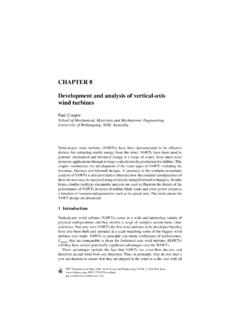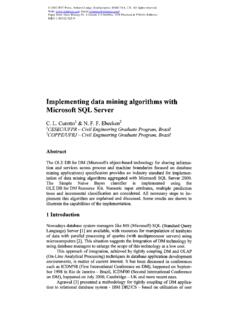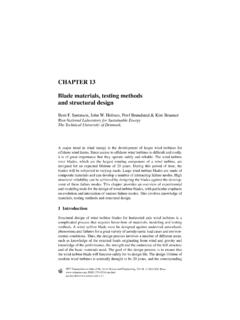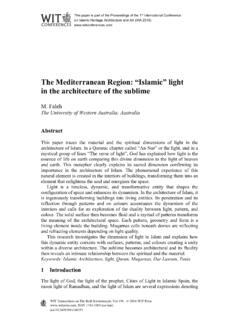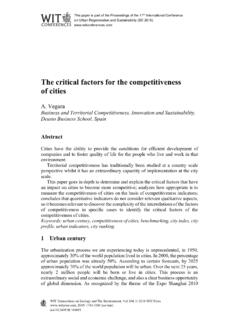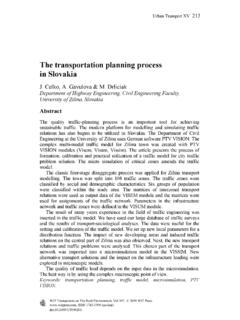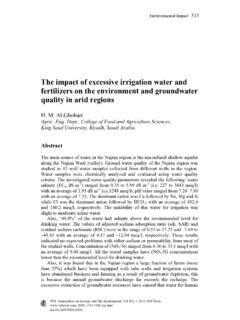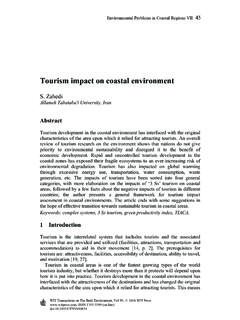Transcription of The use of modelling to implement the Water Framework ...
1 The use of modelling to implement the Water Framework Directive M. Hartnett1, A. Berry2 & K. Irvine3 1 Department of Civil Engineering, National University of Ireland, Galway, Ireland 2 MarCon Computations International Ltd., Newcastle, Galway, Ireland 3 Trinity College, Dublin, Ireland Abstract In December 2000 the European Parliament and Council passed into law the EC Directive 2000/60/EC establishing a Framework for Community action in the field of Water policy, commonly known as the Water Framework Directive (WFD). One of the primary objectives of the Directive is to achieve good ecological status for all waters.
2 The methodologies being adopted by member states are varied using the most appropriate tools; it is specified that one such tool that should be used is numerical modelling . The research reported upon in this paper is the result of a project that was commissioned by the Irish EPA to investigate the role of mathematical modelling in implementing the WFD. The project took account of all categories of models including models of: anthropogenic pressures and impacts: diffuse pollution sources from land; hydrology/hydrogeology/hydrodynamics; dispersion and mass transfer; Water quality; nutrient dynamics; eutrophication processes and aquatic ecosystems.
3 Both inland and tidal waters were covered. The research carried out detailed a review of models and discuss their appropriateness for use. One of the main conclusions arising out of this work was detailing the specific areas within the WFD that would benefit from the use of the application of mathematical modelling . Keywords: Water Framework Directive, modelling , nutrients, heavy metals, GIS, rivers, estuaries, integration. , ISSN 1743-3541 (on-line) 2007 WIT PressWIT Transactions on Ecology and the Environment, Vol 104,River Basin Management IV 11 Introduction The WFD places Water within the context of the catchment through the implementation of River Basin Management Plans (RBMPs), developed for each designated River Basin District (RBD).
4 The WFD will be the effective document under which national legislation will address quality issues within rivers, lakes, transitional waters (mainly estuaries), coastal waters and groundwaters. It also addresses those pressures within the catchment that lead to deterioration or provide risk to Water and its ecology. The WFD has major implications for the sustainable management of both terrestrial and aquatic habitats and requires an approach that necessitates considerable development in the understanding of pressures and impacts on waters and the response of aquatic systems to programmes of measures designed to restore waters of less than good status.
5 There is, therefore, more than an implicit requirement to develop tools to predict the response of surface and groundwaters, and the ecological communities that depend on them, to both increases and decreases in anthropogenic pressures. The implementation of the WFD requires a holistic approach to catchment management that is effected through a more classical reductionism in order to understand salient physical, chemical and ecological mechanisms operating within each domain of the catchment. Within these various domains mathematical models should be utilised to provide synthesis of complex natural processes and to identify the likely response within and among domains of natural and anthropogenic changes.
6 It is difficult to envisage cost-effective and meaningful management without such aids 2 Why model? The use of appropriate mathematical models can help describe or predict ecological processes and response to natural driving variables or anthropogenic pressures. Models can guide management and policies and help in the design of monitoring programmes and interpretation of the results such programmes generate. Models can fill gaps in empirical data. The principles of why mathematical models are useful to the implementation of the WFD are succinctly outlined by Hession and Strorm [1].
7 Models can: help understand complex processes operating within the catchment; fill gaps in monitoring data; identify sources of pollution; predict system response to change; and evaluate management alternatives. The commonly adopted DPSIR (Drivers, Pressures, State, Impact, Response) Framework can be applied to identify the modelling processes applicable to the WFD, see Figure 1. The Drivers are activities in the catchment that lead to pressures on Water resources. For many activities, as illustrated in Figure 1, these pressures are, typically, measurable pollutant loads.
8 For example, a pressure from agriculture may be increased nutrient loads. Increased nutrient loads alter , ISSN 1743-3541 (on-line) 2007 WIT PressWIT Transactions on Ecology and the Environment, Vol 104,12 River Basin Management IVconcentration in the receiving waters, the extent of which is dependent on Water body type, determined by climate and character of the catchment. This defines Water body hydromorphology. Hydromorphology can be altered through physical modifications of Water courses ( channelisation) or land ( drainage). These factors collectively moderate the transfer of pollutant load to in situ concentration.
9 This later factor can be considered to represent the State. It is for this reason that Characterisation of catchments, including the identification of Water body types, is an important requirement (as described in Article 5) of the WFD. The link between Load and State often involves a series of mechanisms of varying complexity. The quantification of load-state can be assisted greatly by mathematical models. Similarly, the effect of pollutant concentration on ecology is moderated by physical, chemical and biotic processes. These are often complicated and multifaceted and, again, mathematical models can be employed to quantify and predict Impacts.
10 The translation of State to Impact also depends on hydromorphology, which requires monitoring under Article 8 and Annex V of the WFD. Figure 1: DPSIR Framework . Some pressures may not, however, impact directly on chemical concentration, but directly on ecology. Pressures from abstraction of groundwater may impact upon quantitative supply of Water to wetlands. Pressures from commercial fishing may have direct ecological effect on abundance and size structure of fish populations. Hence, while the DPSIR model provides useful guidance, it does not necessarily incorporate the whole Pressure to Impact sequence.
